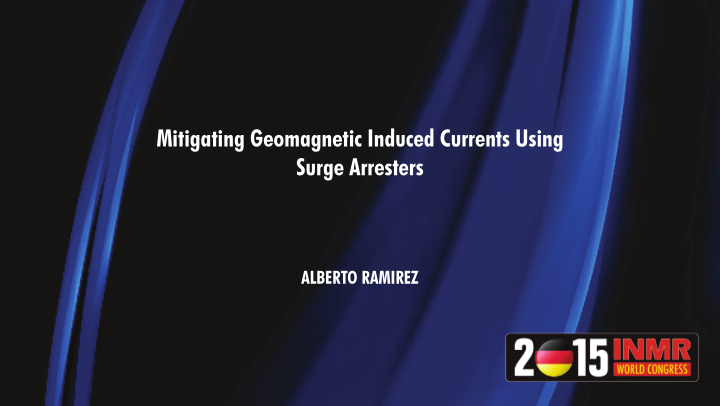



Mitigating Geomagnetic Induced Currents Using Surge Arresters ALBERTO RAMIREZ
MITIGATING GEOMAGNETIC INDUCED CURRENTS USING SURGE ARRESTERS Alberto Ramirez Orquin Vanessa Ramirez University of Puerto Rico Resilient Grids, LLC
General Introducing a simple, cost-effective, means to deal with this hazard Innovative surge-arrester GIC blocking principle Essential discussion regarding the impact of transformer grounding parameters of neutral blocking devices
General Application to transmission grid (auto)-transformer apparatus of typical design Significant invariance of the applicable grounding ratios after arrester device deployment Important revealed features set a plausible benchmarking with capacitive blocking devices
The Surge-arrester Protective Functionality In addition to transformer and line protection, arresters and particularly MOVs have been extensively utilized for series capacitor protection Most transformer neutral blocking devices use surge arresters for transformer winding neutral-end protection
The Surge-arrester Protective Functionality The metal-oxide non-linear resistor has been a well- established technology component for over half a century Use has seen a wide spectrum of electric utility applications, mainly at the transmission and distribution levels
The Surge-arrester Protective Functionality Wealth of references addressing transformer neutral protection Exhaustive series of tests performed at major high- power labs Comprehensive tests series performed at major research labs Extensive simulations performed at the academic level Electric Utility experience
The Surge Arrester GIC-Blocking Functionality Ohm’s Law applied to a non-linear resistor
Comparative of Transformer Neutral Voltage Ranges
Surge-Arrester GMD Mitigation Device
Steady-‑State ¡Performance ¡ Impact upon all AC steady-state variables Impact upon grounding ratio X 0 /X 1
. Steady-State Performance Transformer apparatus basic characteristics Three-winding grounded Wye-Wye-Delta Autotransformer Two-winding Delta-Wye (grounded) GSU apparatus
Steady-State Performance Three-winding Autotransformer Positive/negative sequence Zero-sequence per-unit per-unit equivalent circuit equivalent circuit
Steady-State Performance Three-winding Autotransformer One-line diagram depicting Zero-sequence circuit with isolation from neutral to ground: neutral isolating from zero-sequence flow. ground
Steady-State Performance Three-winding Autotransformer/Numerical Example Grounding Coefficient before and after neutral arrester deployment Nameplate 500/345/100 MVA 500/345/66 KV Grounded YY ∆ Connection X HL = 0.10 pu on a 500 KV/500 MVA base X HT = 0.15 pu on a 500 KV/100 MVA base X LT = 0.13 pu on a 66 KV/100 MVA base
Steady-State Performance Three-winding Autotransformer/Numerical Example Grounding Coefficient before and after neutral arrester deployment Conversion to 500 MVA base X HL = 0.10 pu X HT = 0.15 x 5 = 0.85 pu X LT = 0.13 x 5 = 0.75 pu
Steady-State Performance Three-winding Autotransformer/Numerical Example Grounding Coefficient before and after neutral arrester deployment Windings reactance computation X H = 0.5(X HL + X HT -X LT ) = 0.5(0.10 + 0.85 - 0.75) = 0.1 pu X L = 0.5(X HL + X LT -X HT ) = 0.5(0.10 + 0.75 - 0.85) = 0.0 pu X T = 0.5(X LT + X HT -X HL ) = 0.5(0.75 + 0.85-0.10) = 0.75 pu
Steady-State Performance Three-winding Autotransformer/Numerical Example Grounding Coefficient before neutral arrester deployment
Steady-State Performance Three-winding Autotransformer/Numerical Example Grounding Coefficient after neutral arrester deployment Turns-ratio correction factor and the prevailing zero-sequence High-to-Low reactance becomes: X’ HT = X HT = 0.85x 0.1 = 0.085 pu
Steady-State Performance Three-winding Autotransformer/Numerical Example Grounding Coefficient before neutral arrester deployment = 1.0 Grounding Coefficient after neutral arrester deployment = 0.085
Steady-State Performance GSU Transformer No zero-sequence flow may come from the generation side Zero-sequence unbalance flow may develop from the transmission line side due to load or line-parameter unbalances
Steady-State Performance GSU Transformer Zero-sequence components typically negligible Neutral shift would be limited to a Ferranti rise in the zero-sequence network Arrester device will basically see no real duty from this unbalance examination
Conclusions The metal-oxide surge arrester typically used for protection of power apparatus, in addition to being a component associated to most known GMD countermeasures, is proposed as the very sole element committed to suppress the undesired GIC flow through transformers. Circuit diagram shows the basic arrangement of the scheme introduced, comprising a normally-closed transformer neutral-grounding switch, disposed in parallel with the surge arrester unit.
Conclusions Substantial independent research regarding the surge arrester suitability as a useful protective component of GIC mitigation schemes has been confirmed as reliable transformer neutral- insulation protective functionality when such a device gets deployed. Presented technology and method entirely relieve the need for consideration of blocking mitigation components based on full-size power capacitors or linear-resistors
Conclusions Proposed technology allows for a drastic physical footprint minimization of mitigation devices. Minimizing alternative frequent and onerous GMD- driven preventative operational procedures, mostly implying potentially problematic diversion/ overburden of control centers
Conclusions From a steady-state, current residuals, ground disturbances, parametrical invariance or GIC- blocking perspectives, the standalone arrester device compares favorably with the one based on the condenser, yet without any of its undeniable inherent risks. The difference can only be found at the blocking-function means: one performed by a capacitor bank, the other by an arrester.
Conclusions Capacitor Blocking Device Arrester Blocking Device
Conclusions Legitimate question about the incremental cost/benefit of adding massive capacitor banks merely to secure the flow of inconsequential, quasi-parasitic, ground currents associated to some GSU transformers. Additional incremental cost/benefit questions stemming from the facts that any neutral-blocking unit would operate infrequently and able to reduce slightly about 50 percent of GIC on autotransformer apparatus.
Future Work Further/and on-going Research and Development on early sensing of EMP shock waves Research and Development to address the issue of DC current interruption
Recommend
More recommend